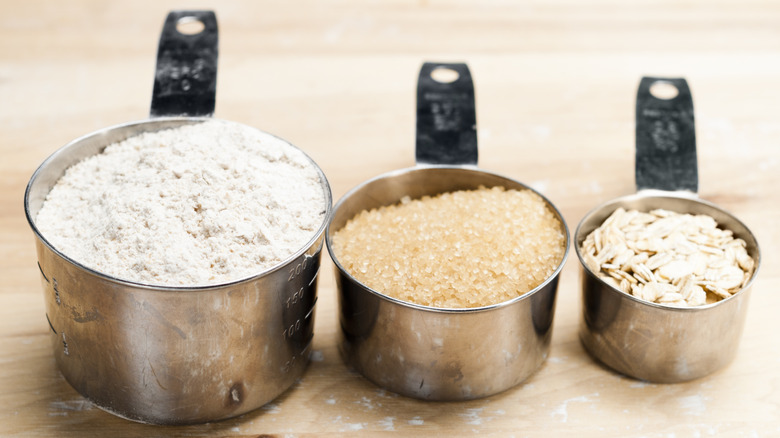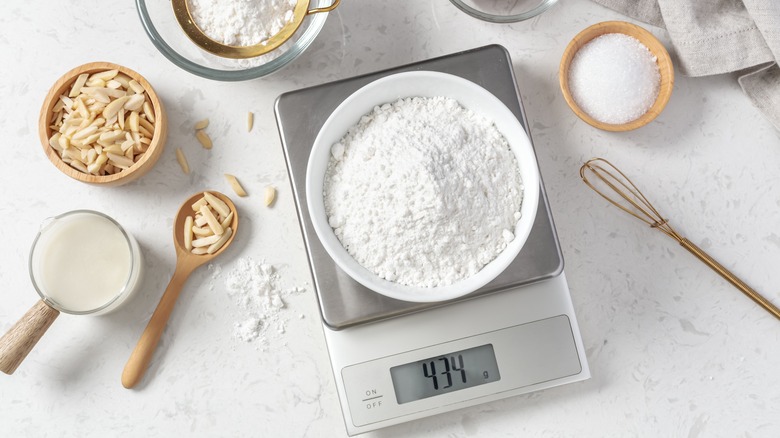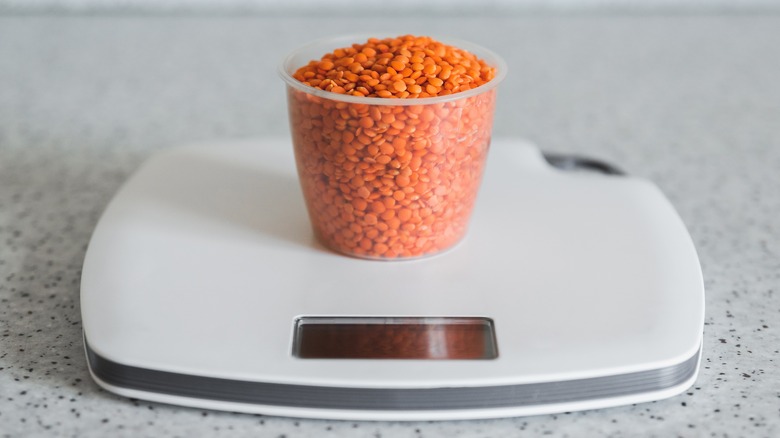The Foolproof Method To Ensure Your Measuring Cups Are Accurate
You may have pondered the nature of weight vs volume — after all, a pound of feathers looks a whole lot different than a pound of potatoes. Flour's density can change quite a bit depending on how you scoop it out of the bag, and in baking you really can't fudge measurements. So how do you know if your measuring cups are doing right by you? You don't! That is until you put them to the test, or in this case on the scale. The key to baking accuracy is to weigh ingredients with a scale.
As tempting as it is to buy seasonally-themed kitchenware, maybe leave it for the tea towels and cutlery, and skip the novelty cup measurers — especially if you intend to bake with them. The biggest issue with fun, irregularly shaped measuring cups is that they're almost always inaccurate. The most common problem with cup measurers is incorrect calibration of measuring lines. According to the Washington Post, some brands (like Oxo) go to great lengths to ensure that their measuring cups are properly calibrated. But even with great care and attention, you can't be entirely sure that they're 100% accurate; that is until you weigh your cup's contents.
Scale tipping
Using a kitchen scale is incredibly simple. Unless you're using the ancient analog version — for which you'll need a degree just to learn how to zero it out — digital scales are as easy as pushing a couple of buttons. These scales can go off calibration, but rarely are there any hiccups when using them. Most professional kitchens use scales and weigh their ingredients out in grams. Why? Because chefs don't have time to do hard math when they've got tons of cooking to do, and it's easier to divide and multiply by whole numbers rather than fractions.
If you want to check the accuracy of your measuring cups, simply weigh out their volume on the scale. It's not that you can't use measuring cups, but the combination of cups and scale is bulletproof. Also, make sure you invest in good-quality measuring cups and spoons; they might not be cute or fun, but they'll get the job done. At the end of the day, a properly baked loaf of bread can be enjoyed just as much as a set of whimsical mushroom-shaped measuring cups.
Forks, spoons, and knives
Some ingredients are easier to be accurate with than others. One of the toughest ingredients to measure correctly is flour. But once you've ascertained that your measuring cups are the real deal, you can measure flour easily with the right technique. Martha Stewart prefers to use the "fluff, spoon, and sweep" method of measuring flour in a cup. The fluffing step in this method entails aerating the flour in its container to help decompress it, which is why folks have just a difficult time getting the right amount of flour into their cup from the jump. Simply give the flour a little jiggle or fluff it with a fork before measuring.
Next, you'll want to spoon the flour. You won't be cuddling the flour in this case, but using a literal spoon to scoop the flour from its container into the measuring cup. Sweep the flour with the straight edge of a knife to level it off gently without pressing it down into the cup. And, if possible, measure the weight of your ingredients just to be sure they're accurate. You can get your hands on a digital kitchen scale for relatively little money — typically anywhere from 20 to 50 dollars — and these scales can be used for all cooking, not just baking. Once you get the hang of living your life in grams, it's a total game changer.


